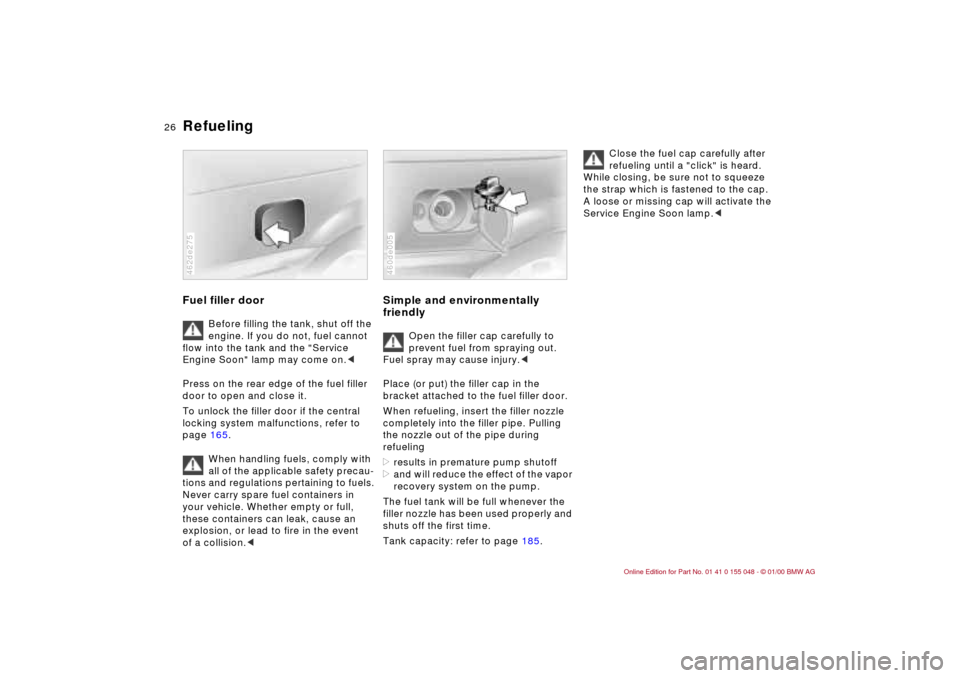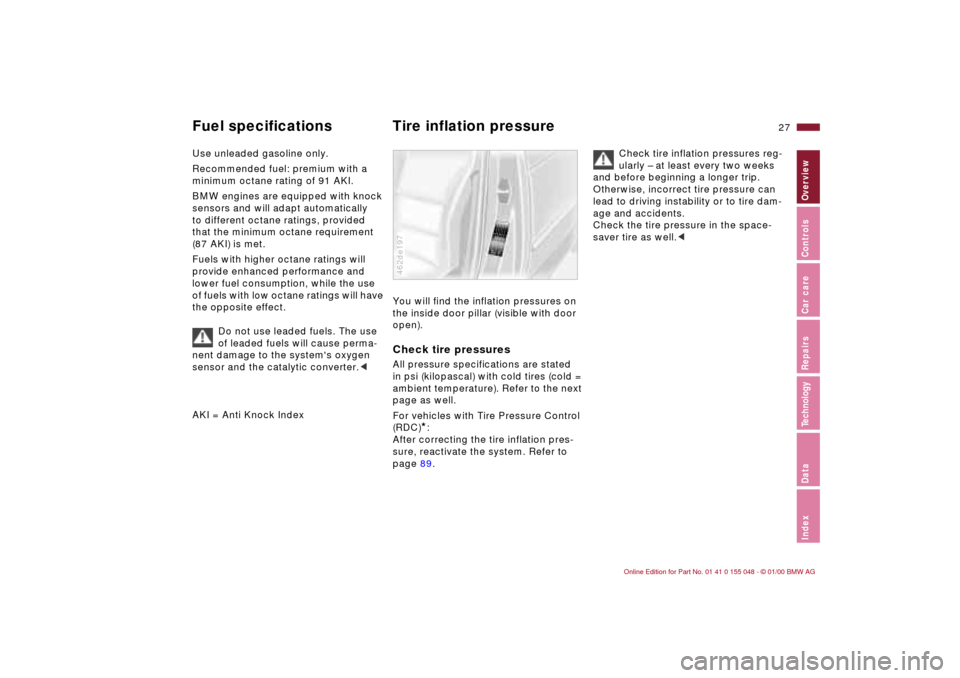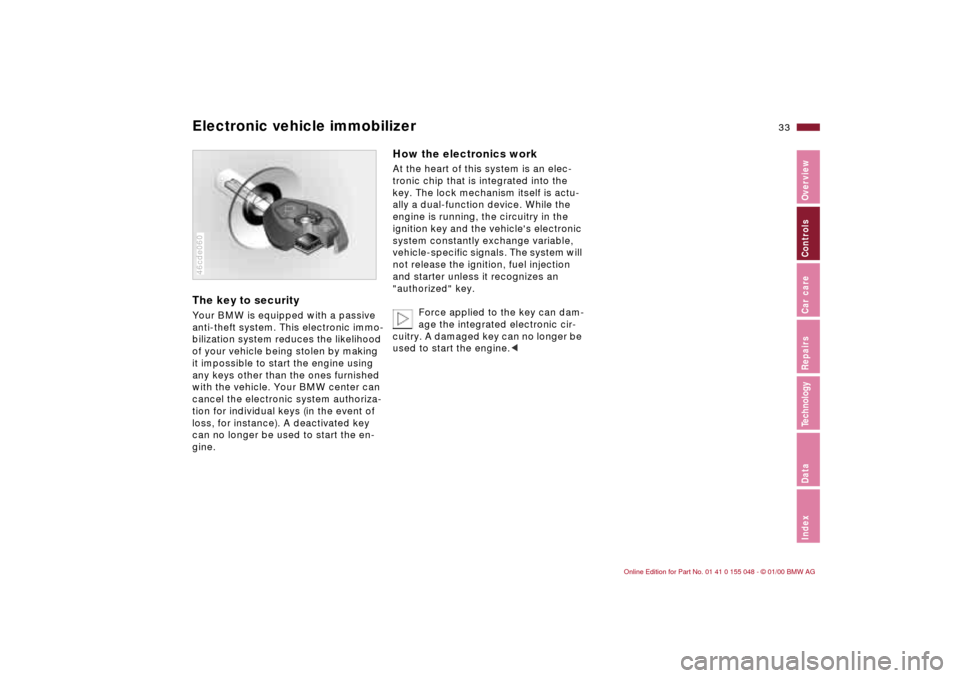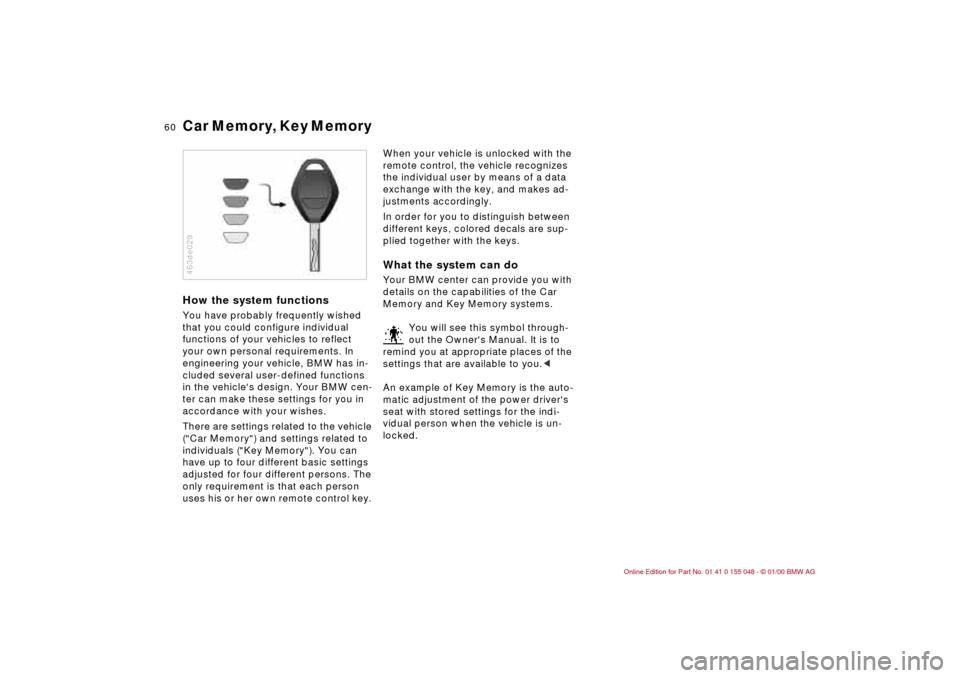2000 BMW 323Ci CONVERTIBLE engine
[x] Cancel search: enginePage 26 of 199

26n
Refueling Fuel filler door
Before filling the tank, shut off the
engine. If you do not, fuel cannot
flow into the tank and the "Service
Engine Soon" lamp may come on.<
Press on the rear edge of the fuel filler
door to open and close it.
To unlock the filler door if the central
locking system malfunctions, refer to
page 165.
When handling fuels, comply with
all of the applicable safety precau-
tions and regulations pertaining to fuels.
Never carry spare fuel containers in
your vehicle. Whether empty or full,
these containers can leak, cause an
explosion, or lead to fire in the event
of a collision.<
462de275
Simple and environmentally
friendly
Open the filler cap carefully to
prevent fuel from spraying out.
Fuel spray may cause injury.<
Place (or put) the filler cap in the
bracket attached to the fuel filler door.
When refueling, insert the filler nozzle
completely into the filler pipe. Pulling
the nozzle out of the pipe during
refueling
>results in premature pump shutoff
>and will reduce the effect of the vapor
recovery system on the pump.
The fuel tank will be full whenever the
filler nozzle has been used properly and
shuts off the first time.
Tank capacity: refer to page 185.
460de005
Close the fuel cap carefully after
refueling until a "click" is heard.
While closing, be sure not to squeeze
the strap which is fastened to the cap.
A loose or missing cap will activate the
Service Engine Soon lamp.<
Page 27 of 199

27n
IndexDataTechnologyRepairsCar careControlsOverview
Fuel specifications Tire inflation pressure Use unleaded gasoline only.
Recommended fuel: premium with a
minimum octane rating of 91 AKI.
BMW engines are equipped with knock
sensors and will adapt automatically
to different octane ratings, provided
that the minimum octane requirement
(87 AKI) is met.
Fuels with higher octane ratings will
provide enhanced performance and
lower fuel consumption, while the use
of fuels with low octane ratings will have
the opposite effect.
Do not use leaded fuels. The use
of leaded fuels will cause perma-
nent damage to the system's oxygen
sensor and the catalytic converter.<
AKI = Anti Knock Index
You will find the inflation pressures on
the inside door pillar (visible with door
open).Check tire pressuresAll pressure specifications are stated
in psi (kilopascal) with cold tires (cold =
ambient temperature). Refer to the next
page as well.
For vehicles with Tire Pressure Control
(RDC)
*:
After correcting the tire inflation pres-
sure, reactivate the system. Refer to
page 89.
462de197
Check tire inflation pressures reg-
ularly – at least every two weeks
and before beginning a longer trip.
Otherwise, incorrect tire pressure can
lead to driving instability or to tire dam-
age and accidents.
Check the tire pressure in the space-
saver tire as well.<
Page 31 of 199

Overview
Controls and features
Operation, care
and maintenance
Owner service procedures
Technical data
Index Advanced technology
31n
IndexDataTechnologyRepairsCar careControlsOverview
Driving:
Steering/Ignition lock70
Starting the engine70
Switching off the engine71
Parking brake72
Manual transmission73
Automatic transmission with
Steptronic74
Turn signal indicator/Headlamp
flasher77
Washer/Wiper system/
Rain sensor77
Rear window defroster79
Cruise control80
Everything under control:
Odometer82
Tachometer82
Energy Control82
Fuel gauge83
Coolant temperature gauge83
Service Interval Display83
Check Control84
Clock84
Onboard computer85
Technology for safety and
convenience:
Park Distance Control (PDC)87
Dynamic Stability Control
(DSC)88
Tire Pressure Control (RDC)89Lamps:
Parking lamps/Low beams91
Instrument lighting91
High beams/Parking lamps92
Fog lamps92
Interior lamps92
Reading lamps93
Controlling the climate for
pleasant driving:
Automatic climate control94
Seat heating99
Cabin conveniences:
Glove compartment99
BMW Universal
Transmitter *100
Storage compartments102
Cellular phone103
Ashtray front103
Cigarette lighter104
Ashtray rear104
Loading and transporting:
Ski bag105
Cargo loading106
Luggage rack for the
hardtop108
Page 33 of 199

33n
IndexDataTechnologyRepairsCar careControlsOverview
Electronic vehicle immobilizer The key to securityYour BMW is equipped with a passive
anti-theft system. This electronic immo-
bilization system reduces the likelihood
of your vehicle being stolen by making
it impossible to start the engine using
any keys other than the ones furnished
with the vehicle. Your BMW center can
cancel the electronic system authoriza-
tion for individual keys (in the event of
loss, for instance). A deactivated key
can no longer be used to start the en-
gine.46cde060
How the electronics workAt the heart of this system is an elec-
tronic chip that is integrated into the
key. The lock mechanism itself is actu-
ally a dual-function device. While the
engine is running, the circuitry in the
ignition key and the vehicle's electronic
system constantly exchange variable,
vehicle-specific signals. The system will
not release the ignition, fuel injection
and starter unless it recognizes an
"authorized" key.
Force applied to the key can dam-
age the integrated electronic cir-
cuitry. A damaged key can no longer be
used to start the engine.<
Page 49 of 199

49n
IndexDataTechnologyRepairsCar careControlsOverview
The fully automatic convertible top
*
The fully automatic convertible top
combines assured protection from the
weather with a one-touch operation.
Here are a few tips to ensure that you
get the most enjoyment out of driving
your convertible.
It is advisable to close the convertible
top when the vehicle is parked. The
closed convertible top not only protects
the passenger compartment from un-
foreseeable damage from the weather,
it also provides a certain degree of theft
protection. In addition, keep valuables
only in the locked luggage compart-
ment, even with the convertible top
closed.
Never mount a roof-mounted luggage
rack on the convertible top.
To prevent damage, do not operate the
convertible top at temperatures below
14 7 (–10 6).
To conserve the battery, operate the
convertible top only with the engine
running if at all possible.
The convertible top operation is
completely automatic. In rare in-
stances, some manual support may be
necessary (see Note in next column
but one).
Operate the convertible top only when
the vehicle is stationary. Do not start to
drive while operating it, either, because
the procedure could be interrupted
when the top hits certain positions.
A partially open convertible top can
lead to damage or injury.
If you initiate convertible top operation
with the vehicle stationary and then
start driving, e.g. at a traffic light, you
can completely carry out the initiated
operation. To do this, press and hold
the corresponding button again.
Give the respectively applicable traffic
rules preference during convertible top
operation, as otherwise you will be in
violation of the law.
Remove any foreign objects from the
windshield frame before closing the
convertible top, otherwise, they could
hinder the opening and closing of the
convertible top.
Do not place any objects on the con-
vertible top, since they would fall off
when the convertible top is operated
and cause damage or injuries.
While driving, always close the rear
power windows first, or close all 4 win-
dows at the same time, otherwise the
windows may not shut tightly at higher
speeds.cDo not reach into the convertible
top mechanism during opening
and closing. Keep children away from
the moving parts of the convertible top
during operation.
The automatic process is immediately
interrupted if the button for actuating
the convertible top is released. The pro-
cess can be continued in the direction
desired by pressing the switch.c
If the convertible top has been
stored in the convertible top com-
partment for an extended period of
time, e.g. during the winter months be-
cause the hardtop
* has been used, it
may be necessary to manually support
the top when closing it automatically for
the first time:
Should the convertible top stop shortly
before it reaches the end of the closing
operation, press from outside against
the front of the convertible top frame
while pressing the switch to help the
top along until it begins moving again
on its own.c
Page 60 of 199

60n
Car Memory, Key Memory How the system functionsYou have probably frequently wished
that you could configure individual
functions of your vehicles to reflect
your own personal requirements. In
engineering your vehicle, BMW has in-
cluded several user-defined functions
in the vehicle's design. Your BMW cen-
ter can make these settings for you in
accordance with your wishes.
There are settings related to the vehicle
("Car Memory") and settings related to
individuals ("Key Memory"). You can
have up to four different basic settings
adjusted for four different persons. The
only requirement is that each person
uses his or her own remote control key. 463de029
When your vehicle is unlocked with the
remote control, the vehicle recognizes
the individual user by means of a data
exchange with the key, and makes ad-
justments accordingly.
In order for you to distinguish between
different keys, colored decals are sup-
plied together with the keys.What the system can doYour BMW center can provide you with
details on the capabilities of the Car
Memory and Key Memory systems.
You will see this symbol through-
out the Owner's Manual. It is to
remind you at appropriate places of the
settings that are available to you.<
An example of Key Memory is the auto-
matic adjustment of the power driver's
seat with stored settings for the indi-
vidual person when the vehicle is un-
locked.
Page 70 of 199

70n
0 Steering lock engaged The key can be inserted or removed in
this position only.
After removing the key, turn the steer-
ing wheel slightly to the left or right until
the lock engages.
Vehicles with automatic transmis-
sion
*:
Do not move the selector lever from the
"Park" position until the engine is run-
ning (ignition key at position 2).
In order to turn the key back to position
0 or to remove it, move the selector
lever into position "Park" first (Inter-
lock).<
46cde093
1 Steering lock disengaged Turning the steering wheel slightly to
the right or left often makes it easier to
turn the key from 0 to 1.
Individual electrical equipment is ready
for operation.2 Ignition onAll electrical equipment and accesso-
ries is ready for use.3 Starting the engine
Vehicles with manual transmis-
sion: depress the clutch when
starting the vehicle. A lockout prevents
the engine from starting if the clutch is
not depressed.<
>Engage the parking brake
>Ensure that the transmission selector
is in "Neutral" ("Park" or "Neutral" if
the vehicle is equipped with auto-
matic transmission
*)
>Step on the clutch pedal when tem-
peratures are low
>Start the engine. Do not press the
accelerator pedal.
Do not actuate the starter for too
short a time, but do not turn it for
more than approx. 20 seconds. Release
the ignition key immediately when the
engine starts.
Do not allow the engine to warm up by
leaving it running while the vehicle re-
mains stationary. Instead, drive off im-
mediately at a moderate engine
speed.<
Do not run the engine in enclosed
areas. The exhaust gases contain
carbon monoxide, an odorless, color-
less, yet highly toxic gas. Breathing the
exhaust gases poses an extreme health
risk, and can lead to unconsciousness
and death.
Never leave the vehicle unattended
with the engine running. An unattended
vehicle with a running engine repre-
sents a potential safety hazard.<
Steering/Ignition lock Starting the engine
Page 71 of 199

71n
IndexDataTechnologyRepairsCar careControlsOverview
Starting the engine Switching off the engine If the engine does not start on the first
attempt (if it is very hot or cold, for in-
stance):
>Press the accelerator pedal halfway
down while engaging the starter.
Cold start at extremely low tempera-
tures, from approx. +5 7 (–15 6)
and at elevations above 3,300 feet
(1,000 meters):
>On the first start attempt, engage the
starter for a longer period (approx.
10 seconds)
>Press the accelerator pedal halfway
down while engaging the starter.Turn the ignition key to position 1 or 0.
Do not remove the ignition key
while the vehicle is still moving. If
you did, the steering lock would engage
when the steering wheel is turned.
When you leave the vehicle, always re-
move the ignition key and engage the
steering lock.
Vehicles with manual transmission:
Always engage the parking brake when
parking on slopes and inclined sur-
faces, since placing the lever in 1st
gear or reverse may not provide ade-
quate resistance to rolling.
Vehicles with automatic transmission
*:
Place the selector lever in "Park".<